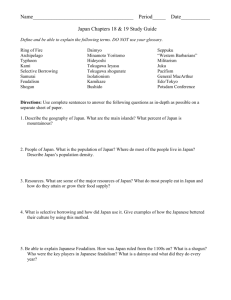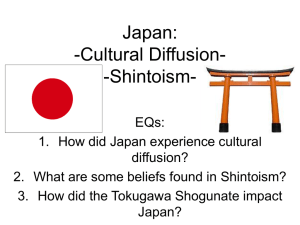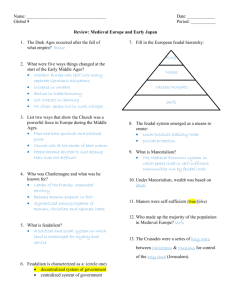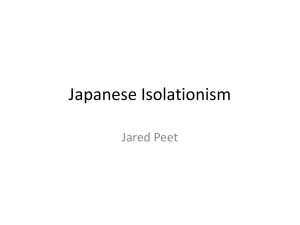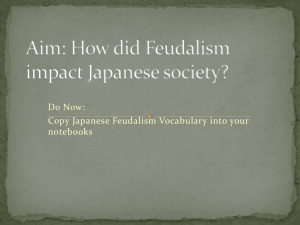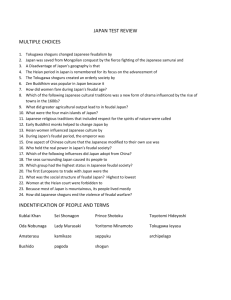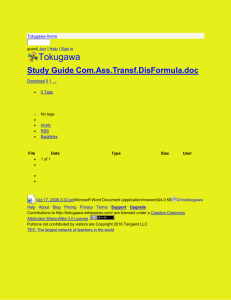Unit Planning for Literacy
advertisement
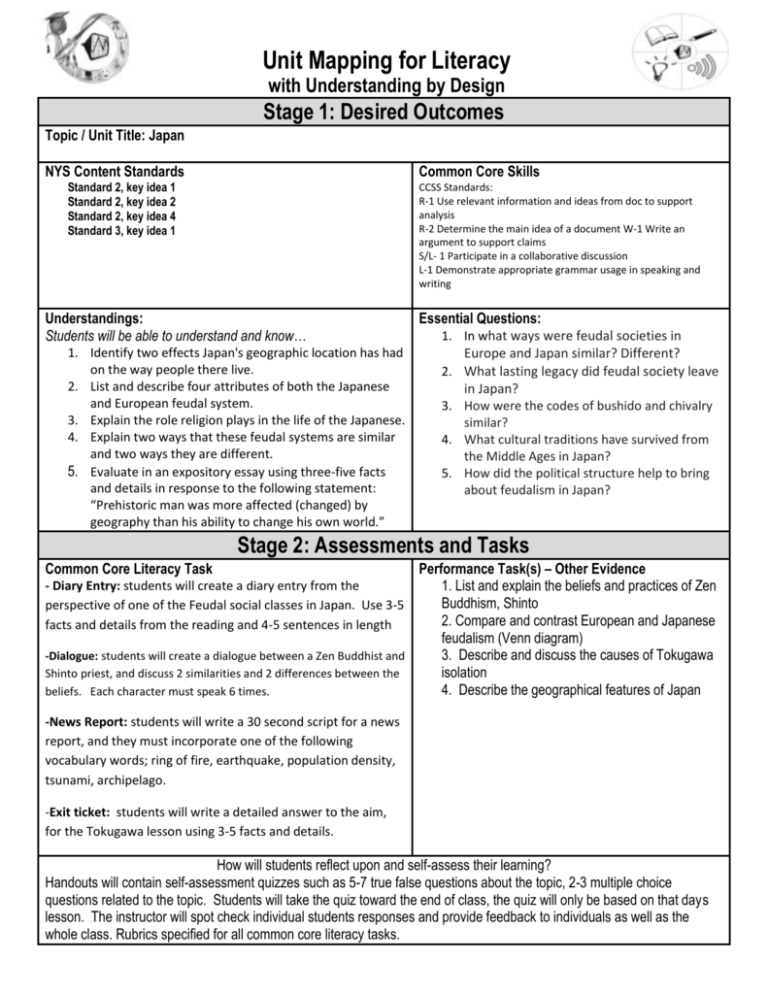
Unit Mapping for Literacy with Understanding by Design Stage 1: Desired Outcomes Topic / Unit Title: Japan NYS Content Standards Common Core Skills Standard 2, key idea 1 Standard 2, key idea 2 Standard 2, key idea 4 Standard 3, key idea 1 CCSS Standards: R-1 Use relevant information and ideas from doc to support analysis R-2 Determine the main idea of a document W-1 Write an argument to support claims S/L- 1 Participate in a collaborative discussion L-1 Demonstrate appropriate grammar usage in speaking and writing Understandings: Students will be able to understand and know… 1. Identify two effects Japan's geographic location has had on the way people there live. 2. List and describe four attributes of both the Japanese and European feudal system. 3. Explain the role religion plays in the life of the Japanese. 4. Explain two ways that these feudal systems are similar and two ways they are different. 5. Evaluate in an expository essay using three-five facts and details in response to the following statement: “Prehistoric man was more affected (changed) by geography than his ability to change his own world.” Essential Questions: 1. In what ways were feudal societies in Europe and Japan similar? Different? 2. What lasting legacy did feudal society leave in Japan? 3. How were the codes of bushido and chivalry similar? 4. What cultural traditions have survived from the Middle Ages in Japan? 5. How did the political structure help to bring about feudalism in Japan? Stage 2: Assessments and Tasks Common Core Literacy Task Performance Task(s) – Other Evidence 1. List and explain the beliefs and practices of Zen Buddhism, Shinto 2. Compare and contrast European and Japanese feudalism (Venn diagram) -Dialogue: students will create a dialogue between a Zen Buddhist and 3. Describe and discuss the causes of Tokugawa isolation Shinto priest, and discuss 2 similarities and 2 differences between the 4. Describe the geographical features of Japan beliefs. Each character must speak 6 times. - Diary Entry: students will create a diary entry from the perspective of one of the Feudal social classes in Japan. Use 3-5 facts and details from the reading and 4-5 sentences in length -News Report: students will write a 30 second script for a news report, and they must incorporate one of the following vocabulary words; ring of fire, earthquake, population density, tsunami, archipelago. -Exit ticket: students will write a detailed answer to the aim, for the Tokugawa lesson using 3-5 facts and details. How will students reflect upon and self-assess their learning? Handouts will contain self-assessment quizzes such as 5-7 true false questions about the topic, 2-3 multiple choice questions related to the topic. Students will take the quiz toward the end of class, the quiz will only be based on that days lesson. The instructor will spot check individual students responses and provide feedback to individuals as well as the whole class. Rubrics specified for all common core literacy tasks. Stage 3: Learning Plan Instructional Activities and Materials (W.H.E.R.E.T.O.) Aim: IS JAPAN’S GEORGRAPHY A BLESSING OR A CURSE? OR HAS NATURE BEEN GOOD TO JAPAN? Performance Objectives: Students will be able to: Define island, archipelago, tsunami. Identify, locate, and describe the major geographic features of Japan. Describe the influence that geography has had on the development of Japanese culture, lifestyles, politics, and religion. Evaluate whether Japans’ geography has helped or hindered its development. Aim: ARE JAPANESE BELIEFS THE PRODUCT OF THEIR ENVIRONMENT? OR DOES RELGION REFLECT A PEOPLE’S CULTURE (Case Study: Comparison of Zen Buddhism and Shintoism) Performance Objectives: Students will be able to: Identify: Shinto, animism, kami, polytheism, torri gate Explain the major beliefs of Shintoism, “way of the kami”, and the ways in which Shintoism has influenced Japanese life. Compare and contrast the philosophical and religious beliefs of Shintoism and Zen Buddhism. Assess the question: “Are the Shinto beliefs in simplicity and respect for nature the keys to contentment in life?” Assess the extent to which the environment of Japan helped to mold the philosophy and religion of the Japanese people and evaluate the question, “Does religion reflect a people’s culture?” Aim: WAS JAPAN’S FEUDAL PERIOD A TIME OF ORDER OR CONFUSION? OR SHOULD PEOPLE GIVE UP FREEDOM TO GAIN SECURITY? Performance Objectives: Students will be able to: Identify: feudalism, daimyo, shogun, samurai, code of bushido. Explain thee reasons for the development and growth of feudalism in Japan. Describe and analyze the various aspects of Japan’s feudal system, including the samurai ethic, loyalty, morality and the growing influence of Zen Buddhism. Assess whether feudalism advanced or retarded Japanese development. Was it a time or order or confusion? Aim: IS ISOLATIONISM BENEFICIAL OR HARMFUL TO A NATION’S DEVELOPMENT? OR IS A STRONG CENTRALIZED GOVERNMENT IN THE BEST INTERESTS OF THE PEOPLE? (Case Study: The Tokugawa Shogunate) Identify/define: Closed Country Edict, Iyeasu Tokugawa Explain the contributing factors (spread of Christianity, influence of foreign missionaries, Spanish conquest of the Philippines) and the immediate causes (rise to power of the Tokugawa Shogunate, fear of foreign aggression) that led to the Tokugawa policy of isolationism. Explain the Tokugawa policy of isolationism which banned Christianity ad all European merchants except the Dutch. Explain the effects of the Tokugawa policy of isolationism: peace and stability, growth of unique Japanese culture, and failure of Japan to keep up with scientific, technical, and military progress. Assess whether isolationism helps or hinders the national interest. Stage 4: Reflection Teacher Reflection for Future Planning
